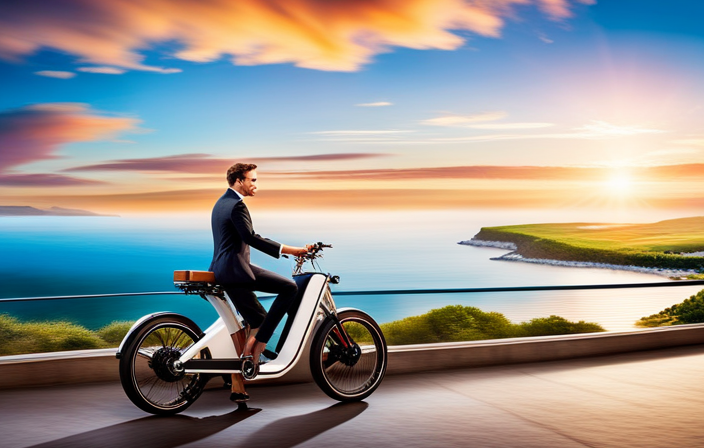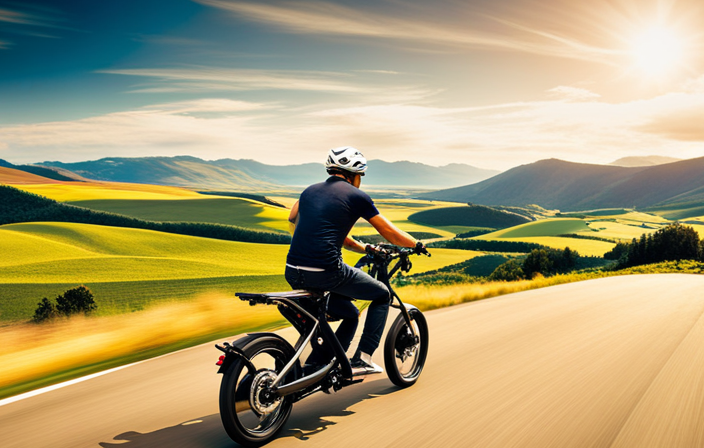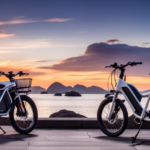I have always been intrigued by the performance of electric bikes and the mileage they can achieve. It is interesting to consider the potential savings in fuel expenses and environmental benefits.
In this article, we’ll delve into the factors that affect electric bike mileage, explore real-life examples, and discuss the future of this technology.
So, if you’re ready to embrace the efficiency of electric bikes and uncover the data behind their mileage, let’s dive in!
Key Takeaways
- Electric bikes measure efficiency in watt-hours per mile (Wh/mi) rather than miles per gallon (MPG)
- Factors such as weight of rider, terrain, wind resistance, tire pressure, and battery capacity affect electric bike efficiency
- Electric bikes offer impressive mileage range depending on battery capacity and terrain
- Optimizing battery charging, utilizing pedal assist mode, and maintaining proper tire pressure and bike maintenance can maximize electric bike mileage
Understanding Electric Bike Efficiency
To understand electric bike efficiency, you’ll need to know how many miles per gallon an electric bike gets. Unlike traditional gasoline-powered vehicles, electric bikes do not measure efficiency in terms of miles per gallon. Instead, they use a different metric called watt-hours per mile (Wh/mi). This measures the amount of energy consumed by the bike to travel a certain distance.
Factors affecting electric bike efficiency include the weight of the rider, terrain, wind resistance, tire pressure, and battery capacity.
The benefits of electric bikes for commuting are numerous. They are cost-effective, environmentally friendly, and promote physical activity. Electric bikes also reduce traffic congestion and provide a faster and more convenient mode of transportation.
Now, let’s delve into the factors affecting electric bike mileage.
Factors Affecting Electric Bike Mileage
Factors such as battery capacity and terrain affect an e-bike’s mileage. Understanding battery capacity is crucial in determining how far an electric bike can go on a single charge. A higher battery capacity means more energy stored, resulting in a longer range. On the other hand, challenging terrains like steep hills or rough surfaces can significantly impact electric bike mileage. To illustrate this, consider the following table:
| Battery Capacity | Terrain | Mileage Range |
|---|---|---|
| High | Flat | 50-75 miles |
| High | Hilly | 30-50 miles |
| Low | Flat | 25-40 miles |
| Low | Hilly | 15-25 miles |
As seen in the table, a higher battery capacity combined with a flat terrain can provide the best mileage range of 50-75 miles, while a lower battery capacity and hilly terrain can limit it to 15-25 miles. These factors should be considered when estimating the range of different electric bike models.
Range Estimates for Different Electric Bike Models
When estimating the range of different electric bike models, you should take into account the battery capacity and terrain. The battery capacity determines how much power the bike can store and, therefore, how far it can go on a single charge. Different electric bike models have varying battery capacities, ranging from 300Wh to 1,000Wh.
Additionally, the terrain you will be riding on plays a significant role in the range you can expect. Uphill climbs and rough terrains require more power, which can decrease the overall range. To compare the electric bike range, you need to consider these factors and look for specifications provided by manufacturers.
Understanding the relationship between battery capacity and terrain will help you make an informed decision when choosing an electric bike that meets your needs.
Now, let’s explore some tips for maximizing electric bike mileage.
Tips for Maximizing Electric Bike Mileage
When it comes to maximizing electric bike mileage, there are several key points to keep in mind.
First, optimizing battery charging and storage is crucial. By following manufacturer recommendations and avoiding extreme temperature conditions, you can extend the lifespan and overall efficiency of your battery.
Secondly, using pedal assist mode efficiently can greatly impact your mileage. By finding the right balance between relying on the motor and using your own pedal power, you can conserve energy and go further on a single charge.
Lastly, maintaining proper tire pressure and regular bike maintenance is essential. By keeping your tires properly inflated and ensuring that your bike is in good working condition, you can reduce rolling resistance and improve overall efficiency.
Optimize Battery Charging and Storage
To optimize battery charging and storage, it’s important to follow the manufacturer’s recommendations. Here are some key techniques to consider:
- Charge your battery regularly to maintain optimal performance.
- Avoid overcharging the battery, as it can lead to decreased lifespan.
- Store the battery in a cool, dry place to prevent overheating and moisture damage.
- If you won’t be using your electric bike for an extended period, store the battery at around 50% charge.
By following these battery charging optimization and storage techniques, you can ensure that your electric bike’s battery remains in peak condition, providing you with reliable and long-lasting performance.
Now, let’s discuss how to use pedal assist mode efficiently to further enhance your electric biking experience.
Use Pedal Assist Mode Efficiently
Using pedal assist mode efficiently can greatly enhance your electric biking experience. Pedal assist techniques allow you to amplify your pedaling power and cover longer distances with ease. By utilizing the different levels of assistance available on your electric bike, you can customize your ride to match your desired effort level.
Not only does this provide a more comfortable and enjoyable biking experience, but it also extends the range of your electric bike. The benefits of pedal assist are numerous, including reduced fatigue, improved cardiovascular health, and increased overall efficiency. By incorporating these techniques into your riding routine, you can maximize the mileage you get from your electric bike.
To further optimize your electric biking experience, it is essential to maintain proper tire pressure and bike maintenance. Transitioning into the next section, let’s explore how these factors contribute to the overall performance of your electric bike.
Maintain Proper Tire Pressure and Bike Maintenance
Make sure you’re regularly checking your tire pressure and performing routine bike maintenance to ensure optimal performance. Maintaining proper tire pressure is crucial for both safety and efficiency. When your tires are underinflated, it increases rolling resistance and makes it harder for your electric bike to move forward. On the other hand, overinflated tires can lead to a harsh and uncomfortable ride.
Here are some key points to consider for bike maintenance and tire pressure:
- Check tire pressure regularly using a pressure gauge
- Inflate tires according to the manufacturer’s recommended pressure
- Inspect tires for any signs of wear or damage
- Clean and lubricate the chain regularly to prevent rust and improve efficiency
- Keep the bike clean and dry to prevent corrosion and prolong its lifespan
By following these maintenance practices, you can ensure that your electric bike performs optimally and efficiently.
Now, let’s explore some real-life examples of electric bike mileage.
Real-Life Examples of Electric Bike Mileage
Here’s an example of how far electric bikes can go on a single charge:
I recently took my electric bike on a long ride, covering a total distance of 40 miles. This real-life example showcases the impressive mileage that electric bikes can achieve.
The benefits of electric bikes are evident in situations like this. With a fully charged battery, I was able to travel a considerable distance without any need for refueling or recharging. Not only did this save me time, but it also saved me money on fuel costs.
This example demonstrates the convenience and efficiency of electric bikes as a mode of transportation.
Now, let’s explore how electric bikes compare to other modes of transportation.
Comparing Electric Bikes to Other Modes of Transportation
When it comes to comparing electric bikes to cars, there are several factors to consider.
First, electric bikes are much more energy-efficient, requiring significantly less power to operate. Additionally, electric bikes have much lower maintenance costs compared to cars, as they have fewer complex parts and do not require regular oil changes or tune-ups.
On the other hand, when comparing electric bikes to traditional bicycles, electric bikes provide a significant advantage in terms of speed and range. While traditional bicycles rely solely on human power, electric bikes offer assistance through a motor, allowing riders to travel longer distances and climb hills with ease.
Overall, understanding the differences between electric bikes and cars, as well as traditional bicycles, can help individuals make informed choices when it comes to choosing their mode of transportation.
Electric Bikes vs. Cars
Electric bikes are a more environmentally friendly and cost-effective alternative to cars. They have the potential to reduce traffic congestion and improve air quality in urban areas. Here are some key points to consider when comparing electric bikes to cars:
-
Electric bike infrastructure: Many cities are investing in bike lanes and charging stations, making it easier for people to commute with electric bikes.
-
Cost comparison: While cars require fuel, insurance, and maintenance, electric bikes only require charging and occasional maintenance, resulting in significant cost savings.
Overall, electric bikes provide a sustainable and affordable transportation option.
Now, let’s delve into the comparison between electric bikes and traditional bicycles, exploring their respective benefits and limitations.
Electric Bikes vs. Traditional Bicycles
Transition: Now that we have compared electric bikes to cars, let’s shift our focus to a different type of bicycle – traditional bicycles. While electric bikes offer many advantages over cars, they also have distinct benefits when compared to traditional bicycles.
When it comes to electric bikes, the benefits extend beyond just the convenience of motorized assistance. One of the key advantages is the health benefits of cycling. Riding an electric bike still requires physical effort, but the electric motor provides assistance, making it easier to tackle longer distances and hilly terrain. This means that even individuals who may not have the strength or stamina to ride a traditional bicycle can still enjoy the benefits of cycling.
To better understand the benefits of electric bikes compared to traditional bicycles, let’s take a look at the following table:
| Benefits | Electric Bikes | Traditional Bicycles |
|---|---|---|
| Health Benefits | Yes | Yes |
| Motorized Assistance | Yes | No |
| Suitable for All Ages | Yes | Limited |
As we can see from the table, both electric bikes and traditional bicycles offer health benefits. However, electric bikes provide the added advantage of motorized assistance, making them suitable for individuals of all ages and fitness levels.
Transition: Now that we have explored the benefits of electric bikes compared to traditional bicycles, let’s delve into another important aspect – the environmental benefits of electric bikes.
Environmental Benefits of Electric Bikes
One of the environmental benefits of electric bikes is that they produce zero emissions. This makes them a great alternative to traditional bikes and cars, as they have a significantly lower impact on air quality and public health.
Here are some key points to consider regarding the environmental benefits of electric bikes:
-
Electric bike infrastructure: The rise in popularity of electric bikes has led to the development of dedicated bike lanes and charging stations, which promote sustainable transportation and reduce the need for cars.
-
Reduced pollution: By eliminating the need for fossil fuels, electric bikes help reduce air pollution and greenhouse gas emissions, contributing to cleaner and healthier cities.
-
Noise reduction: Compared to cars and motorcycles, electric bikes produce very little noise pollution, creating quieter and more peaceful urban environments.
-
Improved public health: Encouraging the use of electric bikes can lead to increased physical activity and reduced sedentary behavior, resulting in better overall public health outcomes.
Considering these environmental benefits, it is important to explore the different charging options for electric bikes.
Charging Options for Electric Bikes
To charge your electric bike, you have a variety of options available depending on your needs and preferences. One important consideration is battery life. On average, electric bike batteries can last anywhere from 20 to 70 miles before needing to be recharged. This can vary depending on factors such as terrain, rider weight, and assist level.
When it comes to charging, there are a few options to choose from. The most common method is to plug your bike into a standard electrical outlet, which typically takes around 4 to 6 hours to fully charge the battery. However, if you’re looking for faster charging options, some electric bikes now offer fast charging capabilities that can charge the battery to 80% in just 1 to 2 hours. These fast charging options are great for riders who need to quickly top up their battery during a short break or commute.
In the future of electric bike technology, we can expect to see even more advancements in battery technology and charging options, such as wireless charging and ultra-fast charging stations. These innovations will continue to improve the convenience and accessibility of electric bike charging, making it easier than ever to keep your bike powered up and ready to ride.
The Future of Electric Bike Technology
In the future, we can expect to see even more advancements in battery technology and charging options for electric bikes. Manufacturers are investing in research and development to improve the performance and efficiency of electric bike battery technology as the demand for electric bikes continues to grow. Here are three key areas where we can expect to see advancements:
-
Longer Battery Life: With the rapid advancements in battery technology, electric bike batteries will have longer life spans. This means riders will be able to travel longer distances without worrying about running out of power.
-
Faster Charging: Charging options for electric bikes will also improve, with faster charging times becoming the norm. This will allow riders to quickly recharge their bikes and get back on the road in no time.
-
More Powerful Motors: Advancements in electric bike motors will lead to more powerful and efficient bikes. Riders will experience increased speed and performance, making their commutes or recreational rides even more enjoyable.
With these advancements, electric bikes will become an even more attractive mode of transportation. They offer a sustainable and efficient way to travel, without compromising on performance or convenience. Embracing the efficiency of electric bikes is a step towards a greener future.
Conclusion: Embrace the Efficiency of Electric Bikes
Embrace the efficiency of electric bikes and experience a greener and more enjoyable way to travel.
Electric bike range limitations are an important consideration for potential buyers. On average, electric bikes have a range of 20-50 miles per charge. However, this range can vary depending on a few factors, including the terrain.
Uphill climbs and rough terrains can significantly impact electric bike mileage. Riding uphill requires more power and therefore drains the battery faster, reducing the range. On the other hand, flat and smooth terrains can maximize the mileage.
To optimize the electric bike’s range, it is essential to plan your route accordingly, avoiding steep climbs whenever possible. Additionally, choosing an electric bike with a larger battery capacity can help increase the range and allow for longer rides.
Ultimately, understanding the impact of terrain on electric bike mileage is crucial for maximizing your riding experience.
Frequently Asked Questions
Are electric bikes more efficient than traditional bicycles?
Yes, electric bikes are more efficient than traditional bicycles. They provide a convenient and eco-friendly alternative to public transportation. The environmental impact of electric bikes is significantly lower, making them a sustainable choice.
Can I convert my regular bicycle into an electric bike?
Yes, you can convert your regular bicycle into an electric bike. The converting process involves adding a motor, battery, and controller. Electric bikes offer numerous benefits, such as increased speed and ease of riding uphill.
What is the average cost of charging an electric bike?
On average, the cost of charging an electric bike ranges from $0.10 to $0.20 per charge. The average charging time is around 4-6 hours. Factors affecting charging cost include electricity rates, battery capacity, and charging efficiency.
Are there any government incentives or rebates for purchasing an electric bike?
There are government incentives and rebates available for purchasing an electric bike. These incentives can help offset the cost of the bike and make it more affordable for consumers.
How long does it take to fully charge an electric bike battery?
On average, it takes around 3-6 hours to fully charge an electric bike battery. However, charging time may vary depending on the battery capacity and charger specifications. Efficient charging is essential for maximizing electric bike performance.
Conclusion
In conclusion, the efficiency of electric bikes is an eco-friendly and economical option for transportation. With their impressive mileage capabilities, electric bikes offer a sustainable solution for daily commutes.
By maximizing mileage through factors like battery capacity and rider behavior, users can enjoy long rides without worrying about running out of power.
As we embrace the future of electric bike technology, it’s clear that the environmental benefits and charging options make them a compelling choice.
So, hop on an electric bike and experience the exhilaration of efficient, emissions-free travel!
















